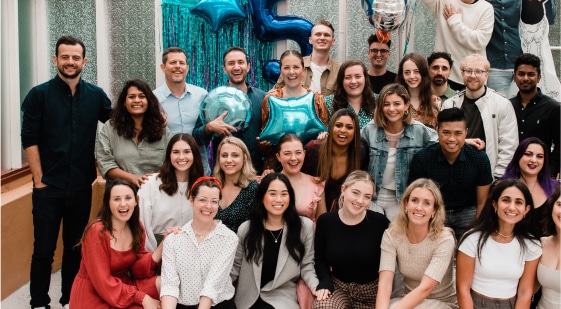Marketing to a Chinese Audience
Episode Description:
Whether marketing into mainland China or Chinese speakers in Australia, a different approach to digital is needed. In this pod, Ophenia Liang shares practical and insightful advice for marketing to a Chinese audience. From the different media platforms you need to be across, to audience segmentation and online behaviours. If you’re marketing to a Chinese audience in Australia or internationally, then this episode is a must-listen!
Key Takeaways:
- The digital media landscape in China and how it has changed since COVID
- The fact China is a market with many many different markets within
- The four big conglomerates in China and how they operate.
- The steps in a user journey when searching for products and services.
- Differences in creative and language
- How to build a marketing strategy/plan for such a diverse and large audience.
- The importance of localising the brand to resonate with a new audience.
- Six-month reviews are more effective than quarterly or annual reviews.
- The practice of engaging with key opinion leaders or key opinion consumers.
- Deep dive into the Australian-Chinese demographics and culture.
Featuring:

Ophenia Liang
About the Guest:
Ophenia Liang is an entrepreneur with a focus in building cross-cultural businesses by realizing talents and resources around the world. Her area of expertise covers cross-cultural team management, strategic marketing planning, international media strategy planning. By trade, she is a specialist digital marketer with both academic and practical experience across the APAC region. She has assisted key global brands to enter and grow in the Chinese market through her strategic planning and execution. She holds a public relations degree from Sun Yat-Sen University, a Masters in Marketing from Melbourne University and is an accredited translator with the National Authority of Translators and Interpreters. Liang is also an expert contributor to Forbes Business.
Ophenia is the winner of City of Sydney Business Award, Young Entrepreneur 2017; Winner of Australia China Alumni Award ( ICT & New Media), and a top 10 Agency Influencer on LinkedIn. You can follow her on LinkedIn. You can also visit the Digital Crew website.
Transcript
James Lawrence: Welcome back to the Smarter Marketer Podcast. I'm here today with Ophenia Liang. Ophenia is the Director and Co-Founder of Digital Crew, a multilingual digital marketing agency working with clients in local and international markets in languages such as Chinese, Japanese and Hindi. Digital Crew has offices in Australia, India, China and the USA, and has worked with brands big and small, including Oppo, L'Oreal, Cebu, Pacific, Western Union, Fraser's, Property, and Allianz. She's also the Co-Founder of Pandometrics, which is a SaaS platform for global brands to monitor their social presence in China. Today, we're going to be discussing marketing to a Chinese audience, both in China and overseas. Ophenia, welcome to the pod.
Ophenia Liang: James, thanks for having me.
James Lawrence: It's great. Excited?
Ophenia Liang: Yeah.
James Lawrence: Me too. I think it's a really interesting topic. We'll kind of get into the numbers and why it is so important, but probably a topic that a lot of Australian marketers, just given the language barrier, just don't have much knowledge about. So I think to get started, if we could just talk about the Chinese market, I guess the size of China’s population, internet users, and then I guess how it's so different to what we have here in Australia, where Australia is very much Google and Meta with Facebook and Instagram and TikTok kind of growing. But yeah, if we could just talk about what digital looks like in China.
Ophenia Liang: Yeah, sure. I think the past three years of the pandemic has separated the whole world. It becomes its own bubble, and there's no difference in China. And the digital space in China has grown a lot in the past ten years. Just think about - there's 1.3 billion, close to 1.4 billion people, and then there are more than a billion people online, and that's the scale of the population online. But as a marketer, we only care about our own audience. So it's actually a very diverse demographic and audience in China because the cities are categorised as a top-tier city and second-tier, third tier, all the way down to fifth-tier, based on the population of the city and the economic status and the GDP of that city. And still, there are more than 100 cities with more than 10 million people.
Ophenia Liang: So when you're talking about, I need to market in China or I need to take my product or brand to China, you really need to be hyper-focused to start with. So when we advise a lot of our clients, we need to do very in-depth marketing research to understand where exactly is their target market? Sometimes we just start with one or two cities. And even within the city, we need to be super-targeted in terms of the digital space. As you know, it used to be the BAT; the Baidu conglomerate, the Alibaba and the Tensor system. And now we have the Baidan system, which is the mother company of TikTok. And in China, they have their own media channels. The biggest one is called Do Ying, which is the sister of TikTok. It's exactly the same, just in Chinese, but in the same group. They have a lot of other media as well, like Tokyo, which is a newsfeed ad. It's the most popular newsfeed app in China. And then they have a group of all other media channels as well.
Ophenia Liang: So these four groups, they are separate. They are in their own little bubbles. So traffic doesn't usually go across these bubbles. So, for example, if you're in WeChat, which is part of the Tencent group, two years ago, you couldn't even have a link to go to Taobao, which is the Alibaba Group. So after ten-plus years of operation, they finally came to an agreement that users could share Taobao link. So from WeChat, you can click a link to go and buy things on Taobao, which is the Alibaba Group. Just like the Amazon of China. And audiences are across all these four big bubble digital conglomerates in China. They still have very diverse and also precise audiences within those different groups because they have many different apps and media, channels, segments and vertical media within those groups. So it's a very huge digital media landscape to navigate in China. And as you know, Google, Facebook and LinkedIn, it's not there. LinkedIn just pulled out about two years ago. It was a shame because a lot of B2B business want to use LinkedIn and it's a very effective channel, but then they pulled out of China. Twitter is not there. So it is like a vacuum from the rest of the world. It has its challenges if a brand or a marketer wants to tackle the market, but once you get to know the landscape and once you find your audience and find the channels that work for you, it will pay off.
James Lawrence: Yeah, I mean, it sounds super overwhelming, doesn't it, in terms of just the sheer vastness of users? The fact that as Australian marketers, we're so accustomed to Google, Facebook, Instagram, LinkedIn, and the idea that you're kind of having to work on a whole bunch of different channels in a different language, it's very interesting. So is it fair to say that of the, say, billion Chinese internet users, most of them would be on each of those four platforms in one way or another? Like you wouldn't be on one?
Ophenia Liang: Yeah, definitely. They're on multiple platforms and sometimes one person will have multiple accounts on different platforms. For example, on WeChat, people have two WeChats because there’s one for work and one for personal. WeChat is basically the app. Everyone is on it. Anyone who has a phone will be on it. And everybody has a phone nowadays because it's manufactured in China. So the cost of smartphone is pretty low in China.
James Lawrence: Because I guess each of these companies has a whole bunch of different products, apps sitting underneath of them. I think the conception in Australia is that Baidu is a search engine like Google, is that kind of true?
Ophenia Liang: Yeah, that is true. Yes. If you talk about the search engine space, Baidu is dominant. They still have about 80% to 85% of the market share in China and then followed by other smaller search engines like 360 or Shenmar. However, the digital habits of Internet users in China are slightly different to the Western user in the Western world. Anything you want to find or want to know, you go to Google and just Google it, right? But in China, it's the Baidu search. It didn't come on. The first step usually depends on what category and what you're looking for. Sometimes you would go to a vertical site such as Jihu, which is similar to Quora. So you go there and search for certain professional questions, knowledge about a specific field, or if you're looking for shopping advice or a brand, or you're trying to buy something, or you're trying to get advice about traveling, how to plan a trip, et cetera. You go to vertical sites, so Sea Trip or Mafungwor about fashion.
Ophenia Liang: You go to Little Red Book, which is dominant 50% female users on there. It has a lot of good content about fashion and cosmeticics and beauty brands. You go there to research about brands and about how other people are talking about those brands, then you go back to the search engine to validate your knowledge. So search engines don’t come on the first step, they come on the second or closer to the last step of a user journey. And then in terms of Alibaba, you'd kind of see that as a shopping Amazon type, e-commerce type equivalent. Tencent, and I know there's probably exceptions to all of these generalisations, but Tencent owns WeChat.
James Lawrence: So probably more in the chat social kind of space?
Ophenia Liang: So all of these internet giants, they have very similar products, but they have the product that they are good at. So, for example, Tencent, the key product is WeChat, which covers every aspect of your life. You chat with your friends, you connect with people you work with there, and also you can make payments, you pay your bills. So WeChat pay. And then there are ecommerce shops within WeChat as well. Then the Alibaba Group, it has its eCommerce, which is very similar to Amazon. It also has its international B2B platform, which is the Alibaba platform, the actual Alibaba platform, which is for sourcing international trade. And then it also has its payment, Alipay. So in terms of the digital payment space, I think China is the fastest country and the most penetration of digital payment. If you go to China right now, you don't see anyone taking out any cash. Everyone just carries their phone and then goes out. 90-year-old grandmas would be just paying by their phone.
James Lawrence: Yeah, I was in Beijing just before COVID and it was unbelievable because I think the kind of the QR code has been around for so long, right, and it was always going to be this big thing and it just never seemed to take off. And in China it was just the default. There are a lot of things you simply couldn't buy if you had cash. So many stores would only accept Pay through an app, and then obviously with COVID the QR code has kind of taken off in Australia as well, but it was fundamentally different, which is interesting. And then in terms of the holding company of TikTok, there's been a Chinese equivalent of TikTok before it took off in the west, is that correct?
Ophenia Liang: Yes, they started actually as a news app, which is called Hotel, which is their star product to begin with. It's the most-read news feed in China. Basically, they just collaborate all the news feeds and then make it into a very user-friendly experience of reading news and a highly personalised newsfeed as well. They launched Doe Ying, which is the Chinese version. They launched that first before they launched TikTok, which is the international version. And Doeing is the dominant app in the video social space in China right now.
James Lawrence: Do you have data in terms of how that platform has grown? In terms of eyeballs in China, is it comparable to something like a WeChat taking up as much time and activity?
Ophenia Liang: It does take up a lot of time because it's video itself. But in terms of users, WeChat has more than a billion users, five years ago already, and it has grown very quickly in seven years. So WeChat is the dominant force. And then in terms of social media, in terms of user base, web has about half of that. So 400 to 500 million users depending on what report you read. There's another challenge in China, which is the data. There's so many data sources and it's very difficult to find accurate data sources. Video users are less. There are multiple reasons. One, is the apps are not as old, so they exist in a shorter time. But more is because of data cost. Even data cost is very cheap in China already. But still, if you think about the fourth or the fifth tier city, where the GDP is lower and the average incomes are lower, the cost of data is quite high for them compared to people in the first tier city. So they use less of these data-consuming apps but still have close to 300 million users. It's quite substantial. And they spend a lot of time on the app as well because itself, the nature of the app, it's consuming time.
James Lawrence: It’s amazing. I think in preparing for the pod, I was reading an HBR article around marketing into China and it's saying that it's extremely mobile first. Basically, everyone is accessing online through their mobile and as you mentioned, kind of old and young. And I think at the time of the article, which is a couple of years back, it was 7 hours per day was the average time that Chinese people are spending on their phone, which was double the amount of time that Americans were averaging each day. So it's really good to have set the ground for that. I guess we're talking about all the platforms and channels that US and Australian marketers are using different in China. The landscape is heavily mobile. There's a lot of usage. The next question for me is, how do you cut through and how do you build a marketing strategy or a marketing plan to scratch the surface? Because it just seems so vast and so overwhelming that it must just be so challenging. If we could talk a little bit about what Digital Crew does in terms of how you take a brand into that market and help them get cut through and help them measure insight into the success of their campaigns?
Ophenia Liang: Yeah, sure. Before we even talk about going into China, we always question, why do you need to go to China? Do you really think the product or the brand has a market space in China? Because you will have local competitors, you have international competitors, and then on top of the complex target audience space and the digital space, once you answer that question, once a brand can fully answer that question, then the work starts. If a client has never been to China, then they need very in-depth market research. You need to be very precise because the market is so big, you will not cover the whole market. No brand has ever covered the whole market. You need to be really precise. So out of a billion target audience, sometimes you target a few million out of a billion. It's a very small number, and we need to know exactly where they are and how to reach them.
Ophenia Liang: And then you need to localise the product or localise the brand, at least that's the minimum. You need to localise a brand. Not just a Chinese name, but how you communicate. Or sometimes you localise your brand itself to fit the local market. And then it's choosing how you communicate, through what channel you communicate, to keep an open mind, because the market changes really fast. So sometimes we run a campaign, it works brilliantly, and then we learn something from it. And then next year, the same time you run the same campaign. It might not work the same way. In the Western world, we usually do an annual marketing strategy planning. We have an annual plan. We do these and then we have a quarterly or monthly review. But in China, if you can plan for six months, it's already really good because the market changes and there are a lot of new trends coming up, and you need to jump onto it. You need to react very quickly to it. So it's very fun. Once you're committed to the market, you learn a lot. It's a very fast-paced market.
James Lawrence: And how do you make decisions like where to go into market? Like you mentioned, the 100 cities, each with 10 million people. And generally you might pick a city or two as a place to go. Is it generally geography? And then what other ways are you cutting up the market to make sure that your customer's message is getting through?
Ophenia Liang: So when we choose, for example, geographic locations, it depends. If it's a physical product, then it depends on the ability of the client to service that market. So can they realistically supply the logistics to service that market? Your distributor might not have the ability to service from the south to the north, it covers such a big landscape. domestic logistics is pretty fast. You can ship something from, let's say south, it's Guangzhou to Beijing. In a day, it will receive however, it's the B2B logistic. Where can your distributor handle it? From international to usually if it's a fiscal product ecommerce or a cross-border ecommerce client, then they probably have their distributor near the Shanghai region or near the Guangzhou region. So we will start from there. So, for example, if it's near the Guangzhou region, then we'll start from the Guangdong province. The Guangdong province already makes up 30% of the entire country's GDP. It's already a very big market. So even sometimes we will just focus on the two cities, for example, Guangzhou and Shenzhen. And it already has a huge population to play with. So start with certain locations that cement your market and then grow to other markets.
James Lawrence: Well, that's it. I mean, we do quite a lot of work marketing our clients into the US. And we're advocating a pretty similar strategy. A lot of which is the American market's roughly 20 times the size of the Australian market. You need to be pretty surgical with what you're trying to achieve and where you're trying to achieve it. And then 30% of the Chinese GDP is probably a market that itself is vast, and you'd want to almost segment as well. And then how geography is one way, but then how do you make decisions around the go-to-market strategy in terms of when are you saying, we're going to go heavily with Search and Baidu or no, we're going to focus on a more of a content kind of social, viral type campaign. If we're in WeChat. How do you get your channel mix right?
Ophenia Liang: Same in the English world, it depends on the client, so it depends on the brand and the product. For example, if it's a tourism client, then it's B2C. They come from a certain CD because it's destination related. In terms of digital channels, there are some certain digital channels they have to be on, for example, WeChat, because everyone is on it. You have to be on it. Have to be a presence based on your target audience. In this case, it's tourism-related. Then you have to be on Red as well, because the domestic consumption of tourism products in China, it's the female decision-making. So Red is 80% female users. And that is one of the big categories that they are strong at in terms of the social media content in tourism. So you have to be on that channel as well. There will be other vertical channels, for example, Mafungwa, Sea, Trip and all of those tourism-specific channels - some of them are booking engines as well as content sharing and tourist experience sharing or review kind of sites. But they are trusted by the consumers in China. Search in this case would be the last step. Just to be there to have a brand presence and not be there for the first step or it's just a small component of the entire experience.
James Lawrence: Are they pay-to-play spaces when you're creating campaigns in the same way that we go into Meta and buy ad space? Are you doing a similar thing or are you generally kind of seeding organic content more in line with how a lot of TikTok work has happened here in the last 18 months?
Ophenia Liang: I think it's a combination and based on the budget and based on how long you need to spend it, it's a combination. So you need to have organic content and you need to buy ads to increase your organic reach. And then the seeding. We will call them KOLs or key opinion leaders or KOCs - key opinion consumers. It's a very common practice to engage with KOLs and KOCs in China. From B2B and B2C brands. They all use these influences, and influencers work across many different platforms. They are professionally trained and there are influencer institutes and influencer colleges in China.
James Lawrence: What a landscape. I guess just in terms of your business, are you doing more work taking international brands into China or are you doing more work helping brands market into Chinese communities, say in the US and in Australia?
Ophenia Liang: I think it's a bit of both as well. And it depends on, for example, in the past three years, pandemic China is completely cut off. Then there's way more work to do domestically. So Chinese in Australia, Chinese in the US. And now China is opening up and all brands are going back to China. Then it's picking up on that front to taking brands into China. Also, in two, three years, there's a lot more Chinese brands coming out of China trying to target the Western audience, trying to build brands to target them. And we're hoping that is a growing segment for us as well.
James Lawrence: Interesting. I'd love to now talk about the Australian Chinese market and I guess just what that looks like. Similarities with the digital landscape in China, but also differences. And so there would be a lot of listeners to the Pod that hopefully some are wanting to market into China, but I think there'd also be many that would be wanting to market to local Chinese. So just be curious as to what that market looks like and your observations from working within it.
Ophenia Liang: So to target Australian-Chinese is actually an easier task compared to the daunting task that we've been discussing. There are about 4 million Chinese in Australia. Some of them are first-generation Chinese and then the second-generation Chinese. The reason I say it's easier is because they are on both Western channels and Chinese channels, so it's easy to reach them. They're very distinct by the language you reach them. We do have a lot of brands that are targeting, we call domestic Chinese. And it's not just the Chinese in Australia. We will run multilingual and multi-ethnic campaigns to target not just the Chinese, but the Filipinos, the Indians, recent migrants and for example, insurance companies, or that they need to target recent migrants as well. The channels are very common. We can use Google, we can use Facebook and then we can use the Chinese channel, for example, Little Red Book or WeChat. They are also on that as well. So the target audience could be very precise.
James Lawrence: guess the biggest difference there is the language. Is that fair to say that you're kind of targeting, say, all Mandarin speakers in Australia and you can pick that up based on simply the fact that that's the language that they're being targeted in?
Ophenia Liang: Yes, language. And there's also the Chinese channels such as WeChat and Little Red Book. They are also users in Australia, so they have a user base. For example, WeChat, out of their billion users in total, there are more than a million in Australia itself. Compared to the billion, it's very small, but compared to the population in Australia, it's not small. So it's a substantial amount of people on those Chinese know that we can target and that is we know for sure they are in Australia and they are Chinese.
James Lawrence: What was the number? Sorry, you mentioned of number of Chinese…
Ophenia Liang: 4 million.
James Lawrence: So of that 4 million, we say 1 million are using WeChat?
Ophenia Liang: That are confirmed by WeChat.
James Lawrence: Yeah. Okay. So still, it's a significant sized audience for Australia.
Ophenia Liang: Yeah, I think so. I think the number is higher. The actual number should be higher. And then the up and coming is the Little Red Book.
James Lawrence: Yeah. We were talking before we went on air about Little Red Book. So it'd be a good thing for listeners to talk about that.
Ophenia Liang: Little Red Book is a social media platform, female dominant. About 80% of users are female. And they're like the Pinkers, a combination of Pinterest and Instagram. So very eye candy content and words as well, so people will share their experiences about certain products, brands or trips, things like that. So I live in Australia and I'm Chinese. I'm on Little Red Book all the time to look for reviews. What to do in the school holidays and where to take them. And it has a lot of local content, local in the sense Australian Chinese content where advice of what brands to buy and what cafes to go to, et cetera. So it's a quite interesting platform.
James Lawrence: Is it too new to have data in terms of the number of Australian users?
Ophenia Liang: They refuse to provide that data, but they did open up the advertising option. So we know that they would not open up advertising option for a certain market unless it has a substantial amount of users. And that amount is usually 300,000 to 500,000 users in that market. So I'm suspecting there must be about half a million users on there for Australia.
James Lawrence: So largely female Australian Chinese?
Ophenia Liang: Fashion, the decision maker in the household.
James Lawrence: Good one. Ophenia, you're mentioning that there's a promo at the moment for users?
Ophenia Liang: Because they opened up the advertising options for Australian brands to advertise on Little Red Book, for the Australian market to target the Chinese for a Digital Crew. We as an agency manage that media and campaigns. So if you sign up as a client for Digital Crew before end of financial year, which is 30 June, there'll be $1,000 off.
James Lawrence: It's not bad. Not a bad way to kind of dip your toe into that local Chinese market.
Ophenia Liang: Yeah, it's hyper, precisely focused.
James Lawrence: I think that's a really good overview of the Chinese digital landscape. A lot of the complexities involved, how it's so different to what we're accustomed to, and also, I guess, how that then transfers into Australia in many ways very similar and in other ways different. What are some of the do's and don'ts, I guess, in terms of marketing into a Chinese audience thinking, whether it's regulatory, whether it's cultural, just the things that you've seen go wrong when Australian marketers have tried to just kind of overlay their thinking into a different market.
Ophenia Liang: In terms of the digital space, all the basics are the same. Like, you look at CPC, you look at CPM, you look at ROIs and conversion rate and all of that are very transferable knowledge. They're the same. But you need to acknowledge the differences and have an open mind in terms of how those Chinese media platforms work. Sometimes they are not as transparent as Google. Some of the advertising functions, they are not as sophisticated. Sometimes, just like Facebook when they started opening up ad options, there are not that many options to choose your demographic. So a lot of this Chinese media, for example, WeChat so the Tencent platform, it's called the WeChat ad platform, and also the GDT platform or the Little Red Book ad platform. In the beginning, they didn't have that many options for you to choose from, just like Facebook. And now they are growing. So they are building as well. So they're growing more sophisticated. They're growing at a different rate. So when you are buying ads from different platforms, sometimes you have more options in one channel and you have fewer options in another channel. So that’s the nature of the development of the market so far. So just need to have an open mind and have patience in this market.
James Lawrence: Interesting. And then in terms of actual creative, you'd be working with your clients to, as you kind of mentioned, rework the brand.
Ophenia Liang: Yeah, everything needs to be localised. It's more than translation. It's localisation of the wording, localisation of the visual, because they have different reading habits, obviously.
James Lawrence: So basically have an open mind. What you apply here is not going to work if literally just translated across to Chinese. And then measurement. In terms of measurement for your campaigns, are you generally still working with clients through, say, Google Analytics to give reporting, or are you kind of pulling into platform data from other analytics?
Ophenia Liang: Yeah, that's a great question. We always get requests of; can I put my Google tag managers in it? Or can I put my UTM tag in my ads? So all of those are very challenging. You can put it in, but it's not going to work. You will not get very precise data. So we will need to use the Chinese platform's analytics. For example, we use Baidu analytics, and we will also use data from the platform itself. For example, from Tencent backhand, they will give you data, and from Little Red Book backend, they'll give you data as well. And also, once they come into your own digital assets, for example, your website or your mobile site or your app or mini program, then you get your data there. That is your own data.
James Lawrence: Yeah, I guess, just as you said, so much of the activity is happening in those platforms that you described as bubbles, that you kind of have to just rely on the data coming out of those platforms as to success or otherwise.
Ophenia Liang: Yeah, that's correct. And they don't share among the bubbles. So if you want the data to merge, you need to bring them to yourself and then you merge from there. So that's actually one of the reasons we build Pandametrics.
James Lawrence: Perfect segue, because that was my next question. If we could just talk about Pandametrics?
Ophenia Liang: Pandametrics is Chinese social media monitoring tool for English speakers, English brands, because we've been helping brands to get into China for so many years, seven, eight years. And that is one of the pain points, getting the correct and accurate data from China. That's why we built this SaaS platform to help brands understand their social media performance in China in English. So we bring out the data of their WeChat, their web, their Little Red Book, and we are building a data source from Taobao as well. So to link the social media data to their ecommerce performance, all in one. One place in Pandametrics for a Western brand to understand. We've launched a 2.0 version and it's live. You can get it from https://www.pandametrics.com/.
James Lawrence: Excellent. Yeah, I'm glad that I asked that question. Yes, that makes a lot of sense. So in terms of just that collating and pulling together of data from those bubbles, I guess, as you describe them, to kind of give us a consolidated view?
Ophenia Liang: Because area is not just the language, is the data source. They don't talk to each other and we want to bring all of the data sources to one place and present it in a way that Western audiences can understand.
James Lawrence: Love it. If anyone's listening to the Pod is interested in, I guess, marketing into China or marketing into a Chinese audience, whether it's here or in the States or anywhere else in the world, what's the best way to get in contact with yourself?
Ophenia Liang: You can go to our website, digitalcrew.com.au. You can contact us from there easily.
James Lawrence: Excellent. And I always end the pod with what's the best piece of career advice that you'd give to a marketer? And I'm happy for you to go broad or I'm also happy for you to say what would be the best piece of advice for a marketer marketing into China?
Ophenia Liang: I think for both questions, I would say keep an open mind and keep learning. The space we are in right now is very different from where we were ten years ago. So I am learning new things every day, even in different markets or just in China or in Australia. So I think keeping an open mind, keep learning. It's very, very important.
James Lawrence: Great advice. Ophenia, thanks for joining us on the Pod.
Ophenia Liang: Thank you, James, for having me.









































